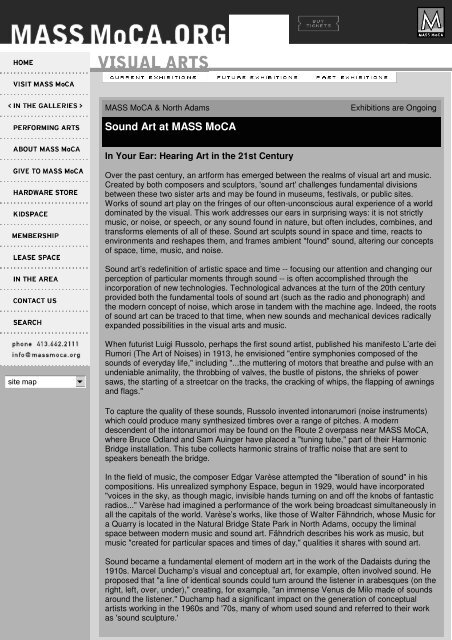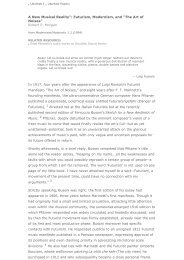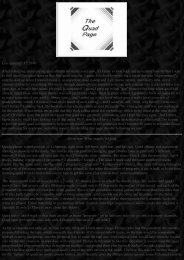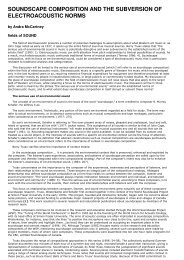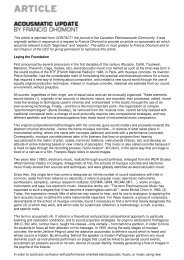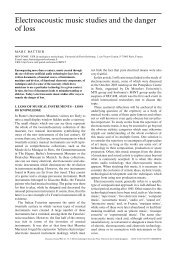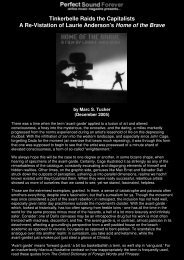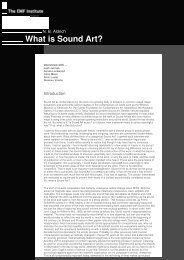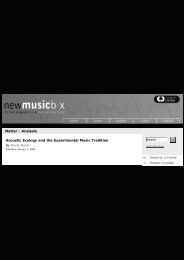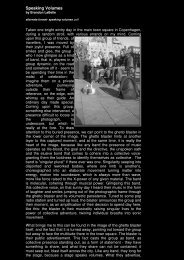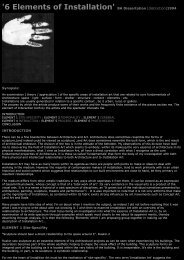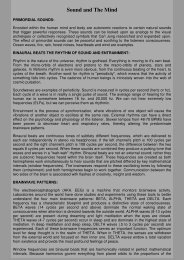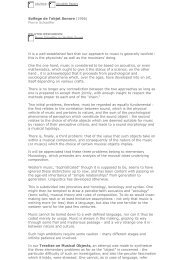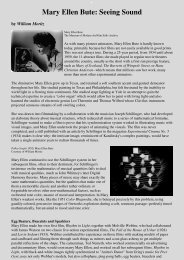MASS MoCA | Visual Arts | Sound Art - An International Archive of ...
MASS MoCA | Visual Arts | Sound Art - An International Archive of ...
MASS MoCA | Visual Arts | Sound Art - An International Archive of ...
Create successful ePaper yourself
Turn your PDF publications into a flip-book with our unique Google optimized e-Paper software.
<strong>MASS</strong> <strong>MoCA</strong> & North Adams<br />
Exhibitions are Ongoing<br />
<strong>Sound</strong> <strong>Art</strong> at <strong>MASS</strong> <strong>MoCA</strong><br />
In Your Ear: Hearing <strong>Art</strong> in the 21st Century<br />
Over the past century, an artform has emerged between the realms <strong>of</strong> visual art and music.<br />
Created by both composers and sculptors, 'sound art' challenges fundamental divisions<br />
between these two sister arts and may be found in museums, festivals, or public sites.<br />
Works <strong>of</strong> sound art play on the fringes <strong>of</strong> our <strong>of</strong>ten-unconscious aural experience <strong>of</strong> a world<br />
dominated by the visual. This work addresses our ears in surprising ways: it is not strictly<br />
music, or noise, or speech, or any sound found in nature, but <strong>of</strong>ten includes, combines, and<br />
transforms elements <strong>of</strong> all <strong>of</strong> these. <strong>Sound</strong> art sculpts sound in space and time, reacts to<br />
environments and reshapes them, and frames ambient "found" sound, altering our concepts<br />
<strong>of</strong> space, time, music, and noise.<br />
<strong>Sound</strong> art’s redefinition <strong>of</strong> artistic space and time -- focusing our attention and changing our<br />
perception <strong>of</strong> particular moments through sound -- is <strong>of</strong>ten accomplished through the<br />
incorporation <strong>of</strong> new technologies. Technological advances at the turn <strong>of</strong> the 20th century<br />
provided both the fundamental tools <strong>of</strong> sound art (such as the radio and phonograph) and<br />
the modern concept <strong>of</strong> noise, which arose in tandem with the machine age. Indeed, the roots<br />
<strong>of</strong> sound art can be traced to that time, when new sounds and mechanical devices radically<br />
expanded possibilities in the visual arts and music.<br />
site map 6<br />
When futurist Luigi Russolo, perhaps the first sound artist, published his manifesto L’arte dei<br />
Rumori (The <strong>Art</strong> <strong>of</strong> Noises) in 1913, he envisioned "entire symphonies composed <strong>of</strong> the<br />
sounds <strong>of</strong> everyday life," including "...the muttering <strong>of</strong> motors that breathe and pulse with an<br />
undeniable animality, the throbbing <strong>of</strong> valves, the bustle <strong>of</strong> pistons, the shrieks <strong>of</strong> power<br />
saws, the starting <strong>of</strong> a streetcar on the tracks, the cracking <strong>of</strong> whips, the flapping <strong>of</strong> awnings<br />
and flags."<br />
To capture the quality <strong>of</strong> these sounds, Russolo invented intonarumori (noise instruments)<br />
which could produce many synthesized timbres over a range <strong>of</strong> pitches. A modern<br />
descendent <strong>of</strong> the intonarumori may be found on the Route 2 overpass near <strong>MASS</strong> <strong>MoCA</strong>,<br />
where Bruce Odland and Sam Auinger have placed a "tuning tube," part <strong>of</strong> their Harmonic<br />
Bridge installation. This tube collects harmonic strains <strong>of</strong> traffic noise that are sent to<br />
speakers beneath the bridge.<br />
In the field <strong>of</strong> music, the composer Edgar Varèse attempted the "liberation <strong>of</strong> sound" in his<br />
compositions. His unrealized symphony Espace, begun in 1929, would have incorporated<br />
"voices in the sky, as though magic, invisible hands turning on and <strong>of</strong>f the knobs <strong>of</strong> fantastic<br />
radios..." Varèse had imagined a performance <strong>of</strong> the work being broadcast simultaneously in<br />
all the capitals <strong>of</strong> the world. Varèse’s works, like those <strong>of</strong> Walter Fähndrich, whose Music for<br />
a Quarry is located in the Natural Bridge State Park in North Adams, occupy the liminal<br />
space between modern music and sound art. Fähndrich describes his work as music, but<br />
music "created for particular spaces and times <strong>of</strong> day," qualities it shares with sound art.<br />
<strong>Sound</strong> became a fundamental element <strong>of</strong> modern art in the work <strong>of</strong> the Dadaists during the<br />
1910s. Marcel Duchamp’s visual and conceptual art, for example, <strong>of</strong>ten involved sound. He<br />
proposed that "a line <strong>of</strong> identical sounds could turn around the listener in arabesques (on the<br />
right, left, over, under)," creating, for example, "an immense Venus de Milo made <strong>of</strong> sounds<br />
around the listener." Duchamp had a significant impact on the generation <strong>of</strong> conceptual<br />
artists working in the 1960s and '70s, many <strong>of</strong> whom used sound and referred to their work<br />
as 'sound sculpture.'
Hugo Ball, founder <strong>of</strong> the Dada movement in Zurich, created the poème simulatane, or<br />
simultaneous poem, first presented at the Cabaret Voltaire in 1916 with "a high-energy,<br />
performance-oriented cacophony <strong>of</strong> whistling, sighing, grunting, coughing, and singing." His<br />
Russian counterparts, such as Wassily Kandinsky and Aleksandr Scriabin, explored similar<br />
topics, such as links between visual and aural perception. Following the Bolshevik<br />
Revolution, Russian artist Arseni Avraamov directed several monumental sound spectacles<br />
in its commemoration. Performed for the fifth anniversary <strong>of</strong> the Soviet Republic, his<br />
Symphony <strong>of</strong> Factory Sirens contained "a huge cast <strong>of</strong> choirs (joined by spectators), the<br />
foghorns <strong>of</strong> the entire Caspian flotilla, two batteries <strong>of</strong> artillery guns, a number <strong>of</strong> full infantry<br />
regiments (including a machine-gun division), hydroplanes, and all the factory sirens <strong>of</strong> [the<br />
port-town <strong>of</strong>] Baku."<br />
American composer, artist, and philosopher John Cage was undoubtedly the central figure in<br />
the redefinition <strong>of</strong> sound from the 1950s to the present. His questioning <strong>of</strong> cultural and<br />
artistic practices largely determined the direction <strong>of</strong> contemporary sound art, temporally and<br />
conceptually bridging that <strong>of</strong> the Futurists and Dadaists working in the 1910s and '20s and<br />
that <strong>of</strong> artists working today. While artists working in the early twentieth century generally<br />
reveled in the new, harsh noises <strong>of</strong> industry and machinery, Cage and many later artists<br />
listened for the subtle harmonies that were generated by chance in the natural and built<br />
environment. In his "silent" piece 4'33", created in 1952, a performer sits at a piano for four<br />
minutes and thirty-three seconds without producing a sound, simply turning the pages <strong>of</strong> the<br />
score and closing and opening the piano lid to indicate the three 'movements' <strong>of</strong> the piece.<br />
Chance determined ambient sound (the coughing <strong>of</strong> the audience, the rustling <strong>of</strong> programs,<br />
and creaking <strong>of</strong> chairs, for example) becomes the music. Christina Kubisch’s Clocktower<br />
Project, drawing from this tradition, also relies on chance: the position and intensity <strong>of</strong> the<br />
sun, mediated by a computer program, determine the sequencing <strong>of</strong> tones in the<br />
compositions; a passing cloud changes everything.<br />
In recent years, festivals in the United States, Japan, Austria, and Germany have highlighted<br />
the multifariousness <strong>of</strong> current sound art practice. <strong>MASS</strong> <strong>MoCA</strong>‘s 1998 Earmarks exhibition<br />
<strong>of</strong> seven sound art installations was one <strong>of</strong> the largest yet held on the East Coast. The field<br />
<strong>of</strong> sound art has remained a fertile one, in part because constant technological innovation --<br />
now, as at the beginning <strong>of</strong> the 20th century -- provides new tools and new concepts <strong>of</strong><br />
sound to those with ears to hear them.<br />
Ronald J. Kuivila<br />
American, born 1955<br />
Visitations (1999)<br />
Located in Cinema Courtyard C, directly behind the information/ticket desk in<br />
our lobby.<br />
The industrial complex now occupied by <strong>MASS</strong> <strong>MoCA</strong> has lain<br />
fallow since 1986 when employees <strong>of</strong> Sprague Electric vacated it.<br />
These people once filled the buildings with sounds <strong>of</strong> industry,<br />
conversation, joking, and complaining - in other words, the "voice"<br />
<strong>of</strong> the now quiet company. Charles Babbage, the father <strong>of</strong> the<br />
digital computer, conceived <strong>of</strong> sounds as immortal, diminishing in<br />
volume but eternally reverberating within the space where they<br />
were made. This notion inspired sound artist Ron Kuivila to<br />
undertake an imaginary excavation <strong>of</strong> the "voice" <strong>of</strong> Sprague<br />
Electric in Visitations. "The history <strong>of</strong> a place is hidden," he says,<br />
"in the gentle murmur <strong>of</strong> its room tone - a din too s<strong>of</strong>t and too<br />
subtle to discern with the human ear."<br />
The relationship <strong>of</strong> space and place to sound is the common<br />
denominator <strong>of</strong> Kuivila's work, a relationship manifested in<br />
Visitations through the incorporation <strong>of</strong> layered visual components<br />
within the former Sprague machine shop. At select windows <strong>of</strong> the<br />
shop the viewer sees a number <strong>of</strong> commemorative Sprague "5<br />
Year Pins," awarded to employees for accumulated service time.
Simple rotary motors, powered by capacitors much like those<br />
manufactured in Sprague's heyday and accompanied by empty<br />
chairs, spin in the middle ground. Finally, orderly regiments <strong>of</strong><br />
over 4,000 capacitors, standing in for the number <strong>of</strong> individuals<br />
employed by Sprague at its peak, are placed on long<br />
workbenches that form a spine down the center <strong>of</strong> the room. This<br />
pastiche echoes Kuivila's layered soundscape emanating from the<br />
walls outside.<br />
Visitations' sonic component is comprised <strong>of</strong> oral interviews,<br />
readings, radio broadcasts, Sprague advertising video<br />
soundtracks, found industrial sounds, and computer generated<br />
noises. Through the incorporation <strong>of</strong> living memory and voices,<br />
however, Visitations illustrates the influence <strong>of</strong> John Cage's<br />
modern musical theory. Cage's work has been described as<br />
acknowledging the "fact that we don't live our lives in orderly<br />
tenses or monotonic modes. We live in messy conversation<br />
located at lively intersections <strong>of</strong> present, past, and future."<br />
Visitations embodies this sentiment, incorporating Cagean interest<br />
in the contribution <strong>of</strong> random and unrehearsed circumstances to<br />
the evolution and completion <strong>of</strong> a work <strong>of</strong> art.<br />
Visitations mines memory for its source material. This fact,<br />
coupled with the difficulty inherent in navigating the past through<br />
oral history, is central to the organization <strong>of</strong> its "narrative."<br />
Through the tradition <strong>of</strong> oral history, people, knowingly or not,<br />
recreate and reshape their own and others' histories. Visitations<br />
<strong>of</strong>fers a glimpse <strong>of</strong> the complex relationships among the past and<br />
present incarnations <strong>of</strong> the buildings on the <strong>MASS</strong> <strong>MoCA</strong> campus.<br />
Bruce Odland and Sam Auinger<br />
Harmonic Bridge (1998)<br />
Bruce Odland: American, born 1952 Sam Auinger: Austrian, born 1956<br />
Plays constantly from 8am to 10pm at the Route 2 underpass on Marshall<br />
Street in the southeast corner <strong>of</strong> <strong>MASS</strong> <strong>MoCA</strong>'s main parking lot.<br />
In the <strong>MASS</strong> <strong>MoCA</strong> portion <strong>of</strong> this multi-part project, Harmonic<br />
Bridge, low sounds roll and drone under the Route 2 overpass half<br />
a block from <strong>MASS</strong> <strong>MoCA</strong>. Entering the space under the bridge,<br />
one becomes aware <strong>of</strong> a turning eddy <strong>of</strong> sound in the midst <strong>of</strong><br />
intersecting streams <strong>of</strong> traffic. Cars pass by heading north or<br />
south on Marshall Street and east or west on the Route 2 bridge,<br />
but this linear motion is counterpoised by a rolling, humming C as<br />
calming as the rhythm <strong>of</strong> ocean waves. Although cars stream by,<br />
pedestrians lose the impetus to move forward, derailed by this<br />
cool pool <strong>of</strong> sound with its mysterious, chant-like hum. Harmonic<br />
Bridge presents an aural cross-section <strong>of</strong> North Adams, a slice <strong>of</strong><br />
the city in the key <strong>of</strong> C, comprised <strong>of</strong> the fundamental note and its<br />
overtone series.<br />
To produce these rolling tones, the artists affixed two 16-foot<br />
tuning tubes to the guardrail on the north side <strong>of</strong> the bridge on<br />
either side <strong>of</strong> the overpass. The length <strong>of</strong> the tubes determines<br />
the fundamental tone: a sound wave at such a low pitch is 16 feet<br />
long and must be generated (whether for sound art or a pipe<br />
organ) with a 16 foot tube. Inside each tube, a microphone is<br />
placed at a certain harmonic interval (the 5th in one tube, the 4th
in the other). These locations emphasize the harmonic and give a<br />
slightly different timbre to the two Cs. (The difference in timbre<br />
between the two tuning tubes is analogous to the difference in<br />
timbre between a cello and a violin playing the same note: though<br />
the pitch is the same, the sound is slightly different).<br />
As traffic passes by, its noise generates a sympathetic resonance<br />
in the columns <strong>of</strong> air inside the tubes. High-pitched sirens and<br />
even voices generate higher harmonics, while the low rumble <strong>of</strong><br />
trucks creates low ones. The sound is carried from the<br />
microphones in the tubes to a control room, where the sound<br />
signal is then amplified and transmitted to the concrete cube<br />
speakers under the bridge. There are no electronic effects added.<br />
The sounds have been simply extracted from the traffic noise<br />
above, as one might extract precious metal from a baser<br />
substance. The pedestrian hears one tuned layer <strong>of</strong> city sounds,<br />
and strains to separate the harmony from the traffic on Marshall<br />
Street. The work requires that we focus our ears on it, and we<br />
walk away from the experience as the composer John Cage<br />
would have us: hearing music everywhere. The bridge becomes<br />
an instrument played by the city revealing hidden harmonies<br />
within the built environment.<br />
The only visible elements placed under the bridge by Odland and<br />
Auinger are the two concrete cube speakers. They are simple<br />
cubes, undecorated save a small tire imprint that suggests the<br />
connection between the sound and the traffic. Yet the space there<br />
is visually transformed by the harmonies. The sound focuses<br />
one's attention on the majestic columns, the elegant proportions,<br />
and grand scale <strong>of</strong> the area, which, combined with the droning,<br />
somehow sacral tones, brings to mind a gothic nave. The<br />
speakers themselves <strong>of</strong>fer places to sit while listening to the<br />
bridge and provide a pleasant respite. Once an imposing barrier<br />
between Main Street and the museum, the underpass is<br />
transformed into a resonating sonic gateway.<br />
Sam Auinger and Bruce Odland have extracted harmonies from<br />
everyday spaces since 1987. They have found rich resonance in<br />
an old traffic tunnel in Strasbourg, a Roman amphora in the<br />
Forum, and the West Side Highway in New York. Their<br />
collaborative works tune public spaces, sifting through noises and<br />
isolating harmonies in found sound. Photo: Nicholas Whitman<br />
Christina Kubisch<br />
German, born 1948<br />
The Clocktower Project (1997)<br />
Can be heard from sunrise to sunset at <strong>MASS</strong> <strong>MoCA</strong>; the brighter the sun, the<br />
stronger the sound<br />
The comparison <strong>of</strong> a city's clock to a person's heart, though it has<br />
been made countless times, remains evocative. When Christina<br />
Kubisch first visited <strong>MASS</strong> <strong>MoCA</strong> in 1996, she was moved by the<br />
fact that the century-old factory clock had not kept time, nor had<br />
its bells rung, since 1986, when the Sprague Electric Company<br />
vacated the 13-acre site. This 19th-century clock, located in an<br />
eighty-foot tower with a 750-pound and a 1,000-pound bell, had<br />
set the rhythm <strong>of</strong> the workday in North Adams since 1895, ringing<br />
every quarter hour. Now those bells and beautiful brass<br />
clockworks share the tower with components <strong>of</strong> The Clocktower
Project: solar panels, electronic sound system, and a computer<br />
with Kubisch's unique program on its flash disc.<br />
Kubisch felt that the loss <strong>of</strong> these bell sounds could be as keenly<br />
felt as the loss <strong>of</strong> an important local building. With this in mind,<br />
she undertook to restore the clock in a way that would also mark<br />
the arrival <strong>of</strong> contemporary art in the city. A classically trained<br />
musician and pr<strong>of</strong>essor <strong>of</strong> experimental art, Kubisch began<br />
playing the bells like musical instruments, ringing them with their<br />
clappers as well as hammering, brushing, and striking them with<br />
her hands and various tools. She recorded the bell tone database<br />
with a digital audio recorder.<br />
Kubisch then placed small solar sensors in a band encircling the<br />
tower just under the bell window. The sensors relay information<br />
about the intensity and location <strong>of</strong> the sun to a computer inside<br />
the tower. A unique s<strong>of</strong>tware program, designed for this project by<br />
Berlin engineer Manfred Fox, interprets the solar information and<br />
combines Kubisch's pre-recorded bell sounds in response to light<br />
conditions. Thus, a sunny summer morning generates loud,<br />
distinct, metallic tones, while a gray afternoon in winter brings<br />
about s<strong>of</strong>ter, somewhat melancholy sounds. At noon and 5pm, the<br />
computer plays a short pre-set concert, but at other times the brief<br />
compositions change with the quality <strong>of</strong> light and time <strong>of</strong> day. This<br />
use <strong>of</strong> unpredictable changes in the weather, coupled with an<br />
algorithmic function in the program that prevents the<br />
mini-compositions from repeating, marks the influence <strong>of</strong> the<br />
American composer and artist John Cage on Kubisch's work.<br />
The fading daylight, registered by the solar panels, causes The<br />
Clocktower Project to fall silent in the evenings. At the same time,<br />
the four faces <strong>of</strong> the clock begin to glow faintly and remain<br />
illuminated through the night. Kubisch coated the 4'-diameter<br />
clock faces with a phosphorescent paint and placed black lights<br />
behind the faces. The cool blue-white light quietly marks the<br />
transformation <strong>of</strong> the tower when the bell sounds have ceased.<br />
Since 1991, Kubisch has made a number <strong>of</strong> hauntingly beautiful<br />
synaesthetic works, culminating in The Clocktower Project, that<br />
allow her audience to "hear the light." Many <strong>of</strong> her recent<br />
installations have focused on the transformation <strong>of</strong> light into<br />
sound using solar panels and ultrasonic devices. Kubisch's<br />
thoughtful investigation <strong>of</strong> the historical sound character <strong>of</strong> the<br />
<strong>MASS</strong> <strong>MoCA</strong> site, and creation <strong>of</strong> a complex, technology-rich<br />
work, typifies <strong>MASS</strong> <strong>MoCA</strong>'s symbiotic approach to site-specific<br />
art. photo: Ben Garver<br />
The Clocktower Installation and Restoration Project was made possible by the<br />
generosity <strong>of</strong> the Clark <strong>Art</strong> Institute in support <strong>of</strong> the Williams Graduate<br />
Program in the History <strong>of</strong> <strong>Art</strong>, the Goethe-Institut Boston, Mary and Henry<br />
Flynt, and Solarex.<br />
Walter Fähndrich<br />
Swiss, born 1944<br />
Music for a Quarry (1999),<br />
Requires a 1/4 mile walk from the Natural Bridge State Park parking lot in<br />
North Adams; plays daily just after sunset<br />
In Music for a Quarry, clear tones call across the natural<br />
amphitheater <strong>of</strong> the Hoosac Marble Quarry from ten speakers,
equally spaced along its circumference, for fifteen minutes <strong>of</strong><br />
twilight every evening. Working with the latitude and longitude <strong>of</strong><br />
the quarry, a computer program begins the music at the same<br />
solar time (rather than clock time) each night. The start time (near<br />
8 or 9 pm in summer, near 4 pm at the winter solstice) changes as<br />
the spatial relationship between the earth and sun changes. The<br />
first tone appears at the precise moment <strong>of</strong> astronomical sunset, a<br />
moment that is both permanently fixed and changing daily. During<br />
this fifteen-minute period, the burden <strong>of</strong> comprehending the<br />
physical space shifts slowly from the eye to the ear as the sounds<br />
are traced to their sources.<br />
Walter Fähndrich has made Musik für Räume (Music for Spaces)<br />
in Switzerland, Austria, Germany, France, and the Netherlands,<br />
though Music for a Quarry is his only work in America. At each<br />
site, whether a Gothic church, art gallery, or outdoor space, he<br />
seeks to create and introduce sounds that rely on the inherent<br />
acoustic qualities <strong>of</strong> the spaces, such as the clear echoes and<br />
fractured surfaces in the Hoosac Marble Quarry. Photo: Nicholas<br />
Whitman<br />
Music for a Quarry received generous support from the Zuger Kulturstiftung<br />
Landis & Gyr, the Sterling and Francine Clark <strong>Art</strong> Institute, the Canton <strong>of</strong> Zug,<br />
Bank Leu AG, the Swiss Center Foundation, the City <strong>of</strong> Zug, the Emil and<br />
Rosa Richterich-Beck Foundation, Pro Helvetia (The <strong><strong>Art</strong>s</strong> Council <strong>of</strong><br />
Switzerland), and Drs. H. and H. Medicus.


